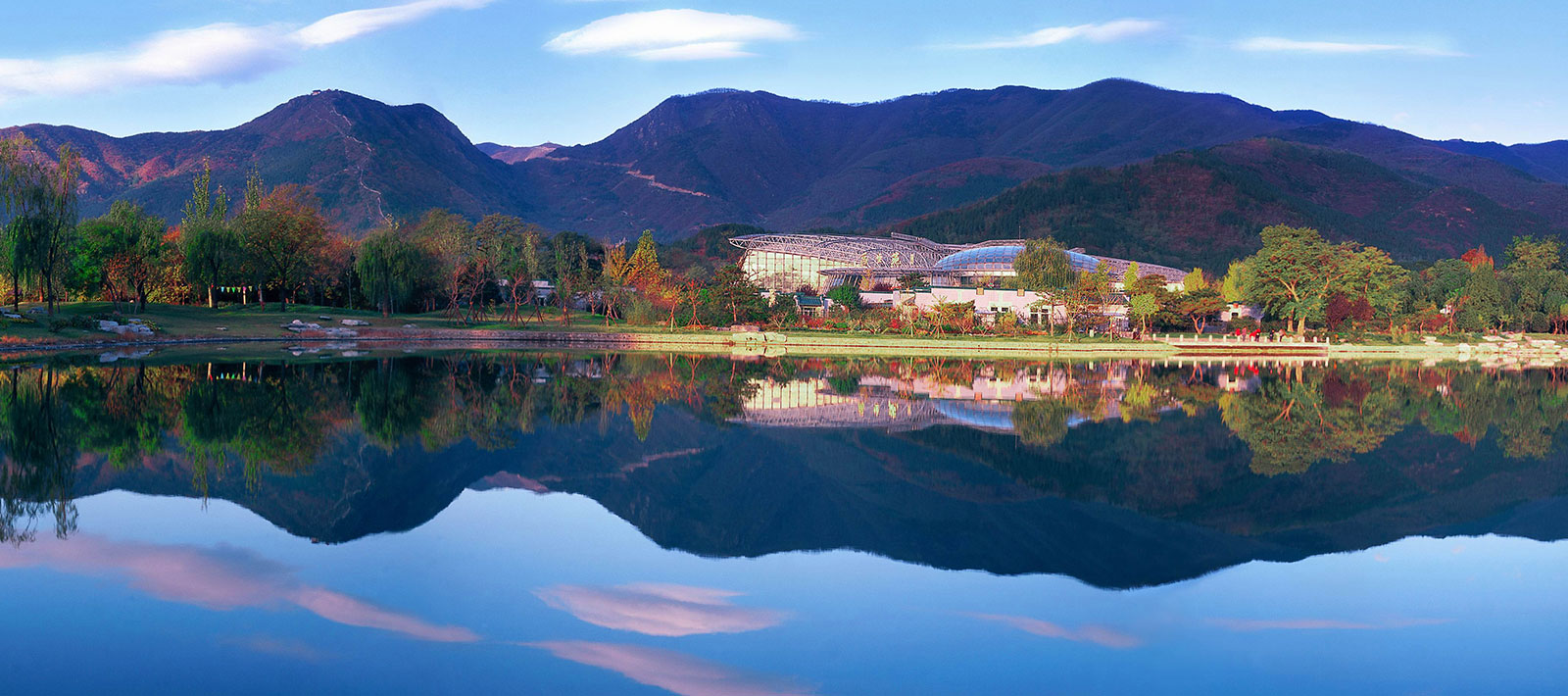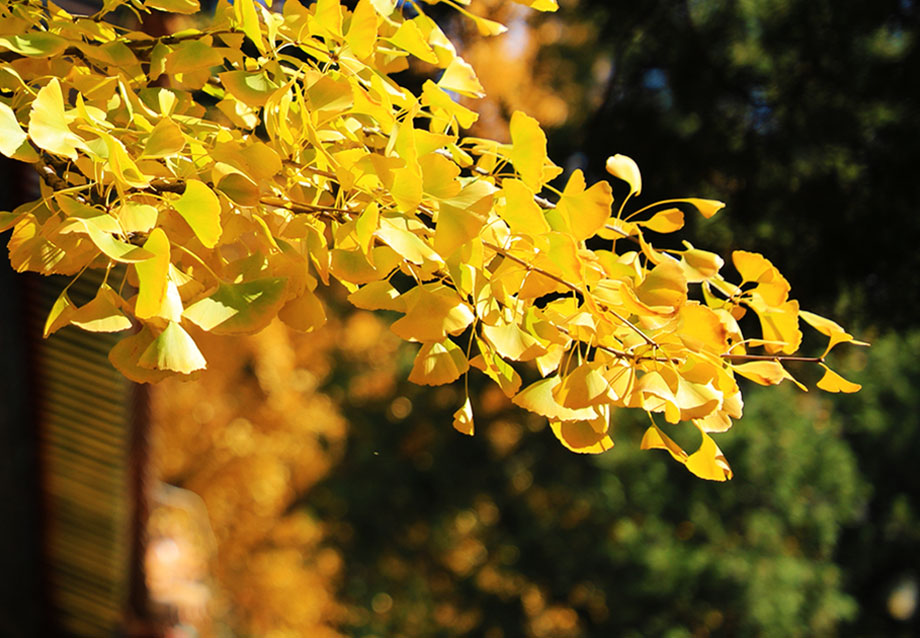Located on the west side of the central axis road of China National Botanical Garden, the conservatory is one of the top ten buildings in Beijing in the 1990s.The total construction area is 17,000 square meters, covering a total area of 5.5 hectares, with an investment of 260 million yuan.The architectural design of the conservatory is undertaken by Beijing Institute Of Architectural Design (BIAD). With the concept of "the memory of green leaves on roots" as the design theme, the "root stem" interwoven sloping glass roof is creatively designed, as if a green leaf was falling at the foot of the West Mountain.
The conservatory mainly displays plantstheir landscapes from tropicalsubtropical areas, providing a base for biodiversity conservation, popular science education, scientific researchviewing.The conservatory is dividedfour main exhibition areas: Flower Hall, Orchid, BromeliadCarnivorous Plant House, Cactussucculent House, Tropical Rainforest House, more than 3100 species (including varieties) than 60000 plants collecteddisplayed.It is an important popular science education base for people to understand plants, feel naturelearn plant knowledge,also an important place for plant resource protectionscientific research.
The Flower Hall is located in the center of the conservatory, in its 3,500 square meters exhibition room, dividedthe central garden and the palm plant /(Arecaceae )/(Palmetto region) area.The central garden is equipped with tall ornamental trees, planted all kinds of seasonal flowers, the layout content is often changed, with rich colors to show the beauty of the four seasons of flowers, visitorsthem such as walking in the sea of flowers.The palm plant area focuses on the palm family plants with different posturerich tropical scenery.Banyan tree/ficus like a flower basket, "living ant nest" Cecropia peltata (horn tree), elegant Plumeria rubra, "blue leaf yellow flower/(green leaves yellow tower)" Pachystachys lutea, "toward dusk fell open" Ruellia simplex, vivid Strelitzia reginae, Gardenia tubifera with windmill flowers you can enjoy here.
Orchid, BromeliadCarnivorous Plant House have an area of 500 square meters.Here through the small bridge flowing water, withered wood strange flowersother artificial scenery, to show us a gorgeousmysterious orchidbromeliad world.This exhibition room mainly displays tropical epiphytes represented by orchidsbromeliads,arranges to cultivate very interesting insectivoresferns.Including Cattleya, Phalaenopsis, Cymbidium faberi, Dendrobium Oncidium,and Guzmania, Lutheria, Cryptanthus, Aechmea and other Bromeliaceae. Moreover, the most noteworthy are the strange carnivorous plants. Nepenthes, Dionaea, Sarracenia and several other strange plants that feed on insects will show you the wonders of nature.
Cactussucculent House covers an area of 1200 square meters, plantingdisplaying more than 1000 kinds of cactusmulti-pulp plants (including varieties), mainly native to tropicalsubtropical aridsemi-arid areas.These plants are very drought-resistant, with cactus mainly native to the Americas, while succulent can be found in Africa, Asia,the Americas.The exhibition room is dividedEuphorbiaceae, stem plant, Cereus, Ferocactus, Kroenleinia, Aloe, Agave, etc.Different water storage methods of the plants are the attractions of this exhibition room. The diameter of 80 cm, Carnegiea gigantea of 5.5 meters high,the unique "scarecrow"(Yucca) all highlight the novelty of the plants in this exhibition room. But as you may not know, these weird-looking plants can open up beautiful flowers, such as Adenium obesum and Euphorbia milii in the exhibition room.Agave americana has the worlds longest tidbits, but it only blooms once in its life,the plant dies naturally. Strange Euphorbia tirucalli English name is called "milk tree", for the succulent trees, strange tree shape, no thornsno leaves, also known as the "bachelor tree". The white milk inside the stem is poisonous, but it produces oil. Although it has no leaves, it can still rely on green branches for photosynthesis. In addition, there are a large number of Cactaceae, Euphorbiaceae, Asphodelaceae and many other novel plants.
The Tropical Rainforest House covers an area of more than 1000 square meters, showing the unique phenomena of single-tree forest, aerial garden, multi-layer structure, vine winding, plate root, dripping leaf tip, strangulation phenomenon, old stem flowers, old dry resultsso on. Entering the tropical rainforest exhibition room, you can feel the richdiverse species here,the plants set each other off, thindense.You will see the conservatory largest plant, a nearly 9 meters high Ficus virens hanged a plant up to 16 meters of Phoenix dactylifera, Ficus virens with its developed gas roots tightly wrapped Phoenix dactylifera,for sunshine, waternutrients, affect the normal growth of Phoenix dactylifera, after more than 20 years in conservatory, Ficus virens hanging failed, let everyone feel the plants in naturesurvivethe cruel competition!The worlds recognized "king of poison wood" —— Antiaris toxicaria, also called arrow poison wood.It is a rare plant in our country, but also a highly toxic plant, whether peoplelivestock, if there is a wound on the body, touched its venom, immediately poisoned,then heart paralysis, vascular closure, blood coagulation symptoms,finally suffocated to death!In addition, you can also enjoy Ficus religiosa, Saraca dives and Crinum asiaticum, which are closely related to the Buddhist culture.
The opening of the conservatory will continue to play the function of preserving plant resourcesprotecting species diversity,become an important place for plants to conserve, popularize scienceimprove national cultural literacy, as well as one of the best places to feel the charm of plants.Tropical exhibition conservatory gives full play to its advantages, as the exhibition window of ecological civilization in the capital, contributes to the world famousworld-class ecological livable city,creates the conservatory into a world-class botanical garden with Chinese characteristics.
.










